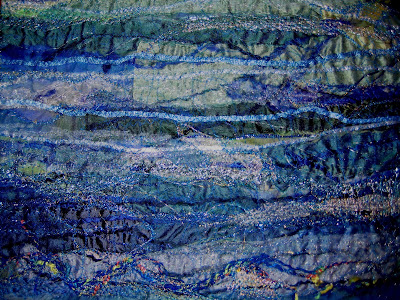
The man I am going to write about was born in the last decade of the nineteenth century. He never had children, so I suppose his name will only occasionally crop up in somebody's family tree. He had an ordinary sort of life (don't most of us?) and yet I don't know of anyone of my acquaintance who enjoyed his life more, or got so much out of it.
The youngest of eight children, born in the fens of Lincolnshire, he was always his mother's favourite, content to stay at home with her rather than go out with his friends. As he grew towards manhood he became passionately interested in two things - gardening and embroidery. From then on he spent his summers doing the one and his winters doing the other.
As I said, he was an ordinary sort of man, not at all an intellectual, only poorly educated. When he left school at twelve he took a job on the railways and became a Plate Layer. It was a job he was to do all his life. And like everything else he did, I am sure he put maximum effort into it. But he lived for his two consuming hobbies.
When his mother died and his siblings all left home, he stayed with his father, bought the house they lived in from their landlord and set about transforming the garden. He loved growing things from seed and soon the garden was a riot of colour, visited by everyone in the village.
In the winters he would sit by the fire and embroider his tablecloths. He would catalogue the hours they took. The one in the photograph took 296 hours - it was written on a piece of paper and pinned to the corner of the cloth.
At the age of forty three, whilst working on the line near to a country house, he became friendly with the spinster who lived there with her brother. The friendship blossomed, forged with the odd glass of port wine and slice of cake that she passed over the fence on to the line when he was working in that area. After a long, old-fashioned courtship they married and she moved in and took over the running of the house.
The relationship as I remember it, was idyllic. She looked after the old man, fed him well, and - if she didn't approve of his nipping to the pub each lunch time (she was a Wesleyan methodist), she turned a blind eye to it. He sucked mint imperials before he came back home and the easy relationship continued until his death.
She and the Plate Layer lived in the same house until their deaths. The garden continued to be magnificent - nemesia were his favourite flowers and I have memories of beds stretching the length of the garden. She kept an immaculate well-run house. There was always a lovely fire in the grate, she was an excellent cook, and they loved nothing better than entertaining friends and relations to tea on Saturdays.
I remember those teas - pork pie, sausage meat patties, salad, queen cakes, fruit cake, home made bread, beautiful china, silver tea pot white damask napkins. But it was after tea that the ritual began.
First of all he would bring out his current tablecloth. We would admire it and after much entreaty he would bring out all the others he had done, all carefully wrapped in tissue-paper in the chest of drawers.
Next we would have to enjoy (or in my father's case - endure) a game of Tiddley-winks - for this was her passion. Years of practise had made her a champion at the game. If I close my eyes I can see her now, tongue held between teeth as she concentrated on a particularly awkward shot!
Then we would gather round the piano for their shared passion. They were both Wesleyan methodists and because there had been no organist in their chapel, he had taught himself to play the hymns on the piano. He never got very proficient and always played the left hand slightly before the right hand - but every week he practised the next Sunday's hymns for hours, so that by Sunday morning he could play them. I suppose our Saturday night's singing round the piano was his dress rehearsal.
By today's standards this might sound a boring life, but I don't think I have ever known two happier people. His gardening got more adventurous, people came from all over to see his chrysanthemums and he sold cuttings at the gate for chapel funds. She continued with her baking and always had a Red Cross stall at any village fair - her cakes would sell like - well - hot cakes!
When I think of him now (they both died in the 1970's) I see a stout, staid man, with big fat workman's hands; a slow and methodical man, not much given to talking, always to be found pottering in his greenhouse or sitting in the bay window with his cloths.
Over the years I know he made at least sixty. I recall one or two - one completely covered with orange calendula marigolds, another with purple and pink pansies - and of course the one in the photograph, which I have had since my teenage days. Although now it is threadbare in places, I treasure it greatly. What happened to the rest of the cloths? I have no idea. But this one stands as a memorial to a man who filled every hour of his life with something interesting to do and who lived a full and happy life. And any one of us should be proud to do that.




